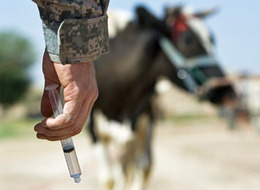Can We Get Antibiotics Out of the Meat Industry?
Posted by Unknown in Animal Health, Cattle and Livestock, Meat, Medicine and Antibiotics, Poultry on Friday, 25 January 2013
I
have a distinct memory from a few years back, when anti-bacterial soap
and the like first became popularized, involving the Utopian promise of
wiping out all bacteria (good and bad) from hands, feet, countertops,
etc. While this promise of a cleaner and more sanitary world had its
appeal, I (along with a few other wary skeptics) wondered if the
eradication of all bacteria was such a good idea; that maybe this
pathogen-free promise was going to bring along unforeseen problems.
Well, we have yet to see the result of our anti-bacterial boon, but in
the fight against disease and pathogens with the use of antibiotics, we
humans have seen spotted trouble on the horizon – especially in relation
to factory farm-raised livestock.
As
a brief primer to the whole issue of livestock (or animals as some of
us tend to overlook) and antibiotics; industrial farms throughout the
United States have been mixing antibiotics into livestock feed since
1946, when studies showed that the drugs cause animals to grow faster
and put on weight more efficiently, increasing meat producers’ profits.
The primary reason that animals are fed antibiotics is because they are
fed a low cost, high calorie corn based diet. This is also the reason
the livestock tend to gain weight so quickly (as much as 70 percent of
all antibiotics used in the United States is fed to healthy farm
animals). Add to this the close confinement these animals are kept in,
as well as the stress and lack of sanitation that many of these animals
contend with, it is no wonder that they become prone to infection and in
desperate need of antibiotic treatment in order to stay alive for as
long as necessary.
But
the liberal use of antibiotics present more complex and knotty
challenges than just ethical ones. According to a New York Times report,
dispensing antibiotics to healthy animals is routine on the large,
concentrated farms that now dominate American agriculture. But the
practice is increasingly condemned by medical experts who say it
contributes to a growing scourge of modern medicine: the emergence of
antibiotic-resistant bacteria, including dangerous E. coli strains that
account for millions of bladder infections each year, as well as
resistant types of salmonella and other microbes. It has been estimated
that at least 18,000 Americans die every year from such drug-resistant
infections, many of which are attributed to liberal antibiotic use.
Now,
contributing to what may be a banner year for the Food and Drug
Administration (FDA), the FDA intends to put its proverbial food down
with new tighter guidelines that would effectively end farm use of these
antibiotic drugs simply to promote faster animal growth. In addition,
the FDA is calling for tighter oversight by veterinarians in an effort
to reduce what it calls a clear risk to human health. All of this FDA
movement comes at a time when vocal criticism of factory farms and
animal confinement has reached a fever pitch, and will undoubtedly be a
welcome relief to the long established status quo. However, not everyone
is looking forward to these tighter regulations, namely livestock
producers who don’t see the direct connection between factory farms,
antibiotic resistant bacteria, and outbreaks of human illness. In
addition, many in the factory farm business argue that more stringent
guidelines on antibiotic use would lead to more animal fatalities and
ultimately a more costly end product. However, the EU barred most
nontreatment uses of antibiotics back in 2006 and farmers there have
adapted without major costs. And it has been proven over the years, in
many different locals with sustainable farms, that animals raised in a
clean, natural environment that is not a breeding ground for bacteria
actually do better than their antibiotic-treated counterparts.
It
is too early to see how all of this shakes out, but in a year where
progressive legislation has been authored to reform egg farms, and a
general growing awareness of the shortfalls of the factory farm model,
it feels like a move in the right direction, especially after the FDA’s
relative inaction over the past decade. I would imagine that many of you
have strong feelings about the current status of factory farms and
their liberal use of antibiotics. I don’t even feel I need ask pointed
questions, as many of you will happily sound off without provocation
below. But please, I invite everyone to share your take on the current
state of being and what is needed for a happier, healthier, and maybe
more ethical food system.
Eric
Steinman is a freelance writer based in Rhinebeck, N.Y. He regularly
writes about food, music, art, architecture and culture and is a regular
contributor to Bon Appétit among other publications.
This entry was posted on Friday, 25 January 2013 at 05:11 and is filed under Animal Health, Cattle and Livestock, Meat, Medicine and Antibiotics, Poultry. You can follow any responses to this entry through the RSS 2.0. You can leave a response.
- No comments yet.






